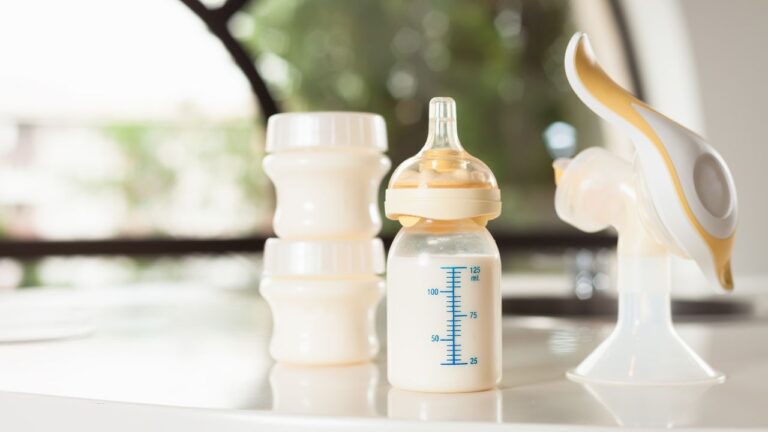How to Increase Your Breast Milk Supply (Fast!)
This post may contain affiliate links and we may earn commissions when you make a purchase through these links (at no extra cost to you). See our disclosure policy for more details.
10 Tips for Combating a Low Supply and Producing More Milk
If you’re worried about low milk production, you’re probably wondering how to increase your breast milk supply fast.
As a mom of two (and one more on the way), I breastfed my babies for more than five years combined, and I’ll be starting up again VERY soon with Baby #3. So you can say I’ve learned a few things along the way!
First of all, there are a few signs to look for when it comes to determining whether your milk supply is truly low and if your baby is getting enough to eat or not. We’ll go over those signs shortly.
(If you’re exclusively pumping and/or already know for certain that you need to produce more milk, you can skip that section.)
If you really do have a low milk supply, we’ll talk about a few ways you can increase your milk supply quickly, in addition to a few other things you might want to know about milk production.
Let’s get started!

I am not a medical professional, and this information is not intended to replace medical advice.
Signs of Low Milk Supply
A lot of moms think that they have a low milk supply when, in fact, they don’t. This is often referred to as Perceived Insufficient Milk.
Is your baby nursing more frequently? More fussy in the evenings?
Did your breasts stop leaking milk, or do they feel softer? Did you stop feeling your letdown?
It’s important to note that these signs DO NOT necessarily mean that your milk supply has tanked.
So, what are some possible signs of a low milk supply?
- Your baby is not having an adequate number of wet and dirty diapers.
- Your baby is not gaining (or is possibly losing) weight.
If you’re noticing that your baby isn’t gaining weight or diaper output has significantly decreased, you should stay in contact with your pediatrician. Also, contact a trained breastfeeding counselor or a certified lactation consultant.
Next, let’s take a look at some signs that can help you determine whether your baby is getting enough milk or not.
Is Your Baby Getting Enough Milk?
It can be worrying if you think your baby isn’t getting enough milk when you’re exclusively breastfeeding.
A few reassuring signs you might look for:
- Baby is gaining weight. A 5-7% weight loss in the first few days is normal, but your baby should be back at his or her birth weight within the first two weeks.
- Baby has adequate diaper output. By the fourth day, your baby should be going through at least six wet diapers and 3-4 dirty diapers.
- You can see/hear your baby swallowing milk.
- Your breasts feel softer after feeding.
- Baby is content after feeding. Hands should be relaxed, and they should be alert and meeting developmental milestones.
Do you still suspect a low milk supply? The next section will cover ways to increase your breast milk supply (fast!).
How to Increase Your Breast Milk Supply Fast
Following are ten of my best tips for increasing your breast milk supply so you can ensure that your baby is getting enough to eat.
1. Nurse on Demand
Breast milk production is based on supply and demand. The more you remove, the more your body will make. This means you should be breastfeeding (or breast pumping) frequently.
2. Remove Milk Efficiently
While you should definitely be removing milk frequently, it’s also important to note that breast milk should be removed efficiently.
If your baby is positioned incorrectly or has a “bad” latch, milk cannot be removed efficiently, which will signal your body to produce less.
Other factors in inefficient milk removal include health and anatomical problems, the use of nipple shields, and even a sleepy baby.
3. Offer Both Sides
After your baby finishes eating from one side, offer the other side to stimulate more milk production — even if your baby doesn’t nurse for long on that side.
For the next feeding, you’ll offer this side first, then once your baby is done, you’ll offer the other side.
4. Try Switch Nursing
Another thing you could try is “switch nursing”. This simply means you’ll switch sides at least three times during a nursing session — basically, anytime your baby falls asleep or starts to lose interest, switch sides.
The idea is that you’ll offer each side at least twice during each session, or as many times as needed until your baby is satisfied.
5. Power Pump
You might have heard of “power pumping”…but what exactly is it?? In place of a normal nursing/pumping session, here’s what you’ll do:
- Pump for 20 minutes
- Rest for 10 minutes
- Pump for 10 minutes
- Rest for 10 minutes
- Pump for 10 minutes
While pumping, massage the breasts and hand express to get more milk. Also, make sure to “dry pump” even when there’s no milk coming out.
Do this at least 2-3 times a day for 2-3 days in a row.
6. Use Heat and Massage
Before a nursing session, apply a warm compress to the breast to help get the milk flowing. You could use a damp washcloth for a moist heat — otherwise, you could even try a sock filled with rice or a breastfeeding hot and cold pack.
Personally, I like to keep a rice bag like this one in the freezer for when the kids get hurt, and then I’ll just warm it in the microwave as needed.
Just be sure to avoid overheating it!! Make sure that it’s a comfortable temperature for your breasts.
When it comes to massage, you can use your fingers and lightly work your way from the top down to the nipple, moving them in a circular motion.
Massage your breasts while pumping or nursing; if you’re finding it difficult to effectively massage with your fingers, you could always try a lactation massager like this one.
7. Replace Pump Parts
If you suddenly notice that you’re not pumping as much as before, it doesn’t necessarily mean there’s something wrong with your milk supply. It could simply mean that you need to replace your pump parts.
According to BabyGaga, changing out parts depends on each part and its condition, as well as how frequently you pump.
- Valves should be replaced every month if you pump three or more times a day, or every two to three months if you pump less than that.
- Membranes should be replaced every two to four weeks if you pump three or more times a day, and every two months if you pump less than that.
- If your pump has backflow protectors, replace them every three months (or every six months if you pump less than three times a day).
- Replace breast shields or connectors every six months, unless you notice damage to them.
- Replace tubing as soon as you notice that it’s moving around or if moisture is getting into them.
8. Take a “Nursing Vacation”
Ever heard of a nursing vacation before? No?
You’re not actually taking a vacation FROM nursing, but rather a vacation from everyday life and doing nothing but resting and nursing in bed for two to three days in order to increase your breast milk supply.
(Of course, you can eat and use the bathroom as needed!)
The idea is to relax and recharge, and to spend some quality time with your baby. Incorporate plenty of skin-to-skin into your nursing vacation, too!
Of course, that’s not always possible if you have other kids to take care of…which leads us to our next tip.
9. Practice Self Care
If you can’t take a full-blown nursing vacation, at least take some time for practicing self-care.
Of course, this includes relaxing when you can, but self care is so much more than taking a bubble bath (which can be somewhat difficult with a baby around!).
Otherwise, just stay hydrated (without drinking in excess — running to the bathroom every ten minutes isn’t exactly relaxing!), eat well, and sleep when you can.
10. Consider a Galactagogue
A galactagogue is a substance that can help increase your milk supply, such as a medication or herb.
Since most people can improve their milk supply in other ways, though, it’s best to save this one for last, and only resort to galactagogues if you truly have a low supply.
They tend to work best when used in conjunction with some of the above tips, such as more frequent nursing/milk removal.
And, of course, before using any of these substances, you should talk to someone who is knowledgeable in this area. Some herbs, such as fenugreek, can actually have the opposite effect and lessen milk supply.
How Quickly Can I Increase My Milk Supply?
Wondering how to increase your breast milk in one day? Unfortunately, it can take a little longer than a day to notice a change in your milk supply — but don’t stress about it!
Worrying won’t increase production, but relaxing and following the tips I’ve outlined above could certainly help. Just know that it could be a few days before you see results.
Final Thoughts
Have you tried any of these ten tips to quickly increase your breast milk supply? Did they work for you?
Fortunately, most of us are able to produce the amount of breastmilk that our babies need simply by feeding on demand.
However, there is a small percentage who have a true low (or nonexistent) milk supply for some reason or another, in which case I would recommend consulting with a professional for a proper diagnosis.
Related:
How to Get Rid of a Clogged Milk Duct FAST (Without Pumping)
Best Wearable Breast Pump for Pumping on the Go: Willow vs. Elvie







